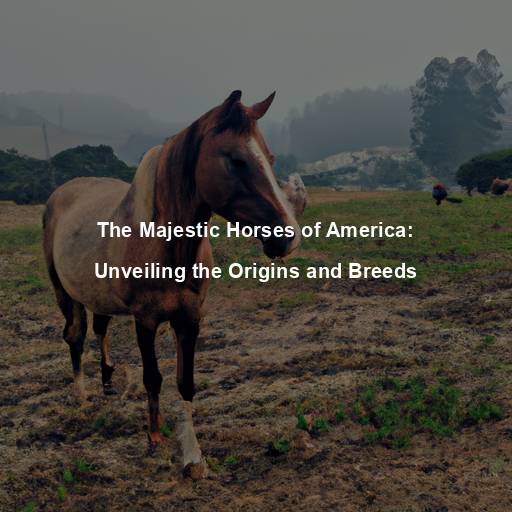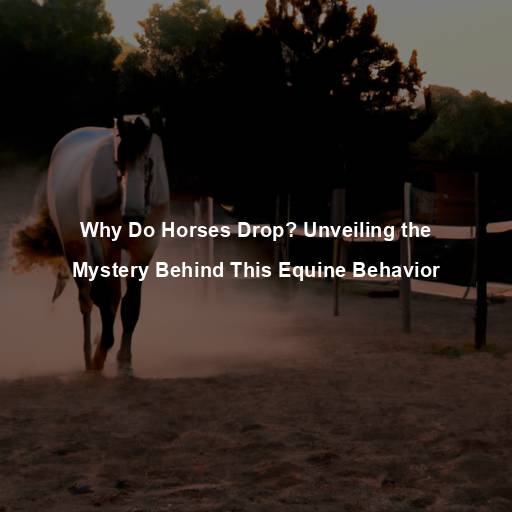Why Horses Die at Kentucky Derby: Unveiling the Tragic Reality
Last Updated on October 19, 2023 by Evan
Contents
- 1 The Prestigious Kentucky Derby: A Glorious Tradition
- 1.1 The Demanding Nature of Horse Racing
- 1.2 The Perils of Fragile Bones
- 1.3 The Unforgiving Track Surface
- 1.4 The Dark Shadow of Medication
- 1.5 The Pressure to Perform
- 1.6 The Pursuit of Change
- 1.7 A Call for Compassion and Awareness
- 1.8 Strides Towards Safer Racing
- 1.9 Advancements in Training and Conditioning
- 1.10 The Role of Technology in Equine Health Monitoring
- 1.11 Educating Industry Professionals and Stakeholders
- 1.12 The Journey Towards a Safer Future
- 1.13 Unveiling the Controversies
- 1.14 Raising the Standards: Ethical Reforms in Horse Racing
- 1.15 A Call for Responsible Engagement
- 2 FAQs: Why Horses Die at Kentucky Derby
- 2.1 What are some reasons why horses die at the Kentucky Derby?
- 2.2 Are there any specific injuries that horses commonly sustain during the Kentucky Derby?
- 2.3 What measures are taken to ensure the safety of the horses participating in the Kentucky Derby?
- 2.4 Do horse fatalities occur frequently at the Kentucky Derby?
- 2.5 How does the racing community respond to horse fatalities at the Kentucky Derby?
The Prestigious Kentucky Derby: A Glorious Tradition
Known as “The Most Thrilling Moment in Sports,” the Kentucky Derby steals the hearts of global viewers with its exhilarating horse races. Each year, at Churchill Downs in Louisville, Kentucky, this celebrated event has experienced a remarkable rise in fame and prestige. However, amidst the grandeur and excitement, a sorrowful truth casts a shadow over the Derby: the heartrending loss of the noble horses that partake in the race. In this article, we explore the perplexing factors behind these unfortunate deaths, shedding light on a somber reality that coexists with the magnificence of this legendary spectacle.
The Demanding Nature of Horse Racing
Horse racing, including the Kentucky Derby, is an intensive and demanding sport that pushes both the equine athletes and their jockeys to their limits. The race entails a grueling distance of one and a quarter miles, with horses thundering at incredible speeds, often exceeding 40 miles per hour. The combination of high speeds, extreme physical exertion, and competitive pressure places an immense strain on the horses’ bodies, making them susceptible to injuries and, in some cases, fatal accidents.
The Perils of Fragile Bones
The captivating allure of the Kentucky Derby is often marred by the somber reality of horse fatalities that leave us pondering the perplexity of such tragedies. It is a harsh truth that lies within the delicate nature of the equine skeletal system, concealed beneath their majestic and sturdy façade. While horses possess an aura of resilience, their slender limbs bear the weight of immense strain during the exhilarating race, as they swiftly maneuver through treacherous turns and gallop at extraordinary speeds. The fragility of their bones presents a precarious balance, as even the most minute error in stride or landing can unleash a sequence of catastrophic events, forever altering the fate of these noble creatures.
The Unforgiving Track Surface
Another factor that contributes to the unfortunate demise of horses in the Kentucky Derby is the track surface itself. The racing surface, typically composed of dirt or synthetic materials, can have a significant impact on the horses’ performance and safety. The composition and maintenance of the track play a crucial role in determining the level of traction and shock absorption available to the horses. Inadequate track conditions, such as excessive hardness or inconsistent footing, increase the risk of accidents and injuries, amplifying the chances of fatal incidents occurring.
The Dark Shadow of Medication
One of the most controversial aspects surrounding the Kentucky Derby is the use of medications in horse racing. While regulations exist to ensure the welfare of the horses, some argue that certain substances may be used to enhance performance or mask underlying health issues. The administration of medications, such as painkillers or anti-inflammatory drugs, can potentially mask injuries or conceal discomfort, leading to the participation of horses that are not in peak physical condition. This, in turn, increases the likelihood of catastrophic injuries during the race, ultimately resulting in tragic consequences.
The Pressure to Perform
Every year, the Kentucky Derby captivates the world with its grandeur and prestige. Behind the scenes, however, lies a complex web of competing interests and aspirations. The immense financial stakes place a burden on horse owners, trainers, and breeders, who find themselves navigating a treacherous landscape of ambition and pressure. In this high-stakes game, the well-being of the horses can sometimes be overshadowed, as the pursuit of victory becomes all-consuming.
The Pursuit of Change
In the wake of the Kentucky Derby’s unsettling horse fatalities, a chorus of voices has risen, demanding change and raising profound questions about the future of horse racing. The urgency is palpable as multiple groups and individuals tirelessly strive to establish stringent safety protocols, enhance track conditions, and tighten regulations surrounding medication practices. Amidst these challenges, the promising advancements in veterinary medicine and horse training methods offer a glimmer of hope, fueling a collective determination to reconcile the exhilaration of the Kentucky Derby with the preservation of these majestic creatures’ lives. As the horse racing industry grapples with this perplexing dilemma, the pursuit of a harmonious equilibrium persists.
A Call for Compassion and Awareness
As lovers of the exhilarating sport of horse racing, it is imperative that we confront the perplexing issue of the risks associated with it and actively champion the protection and care of these majestic beings. While the Kentucky Derby remains a captivating display of skill and speed, it is essential to acknowledge the immense sacrifices made by these equine athletes. By endorsing measures that prioritize the safety and well-being of horses, we willingly tread a path towards a future where the devastating loss of these remarkable creatures becomes a rarity, allowing the true essence and thrill of the Kentucky Derby to shine unfettered by the shadows of tragic events.
Get ready for an exclusive inside look as we continue our riveting exploration into the realm of Kentucky Derby’s safety protocols, shedding light on the tireless dedication to preserving the integrity of this exhilarating sport. In the upcoming installment, we will dive into the intricate web of measures established to safeguard the equine athletes, leaving no stone unturned in our pursuit of untangling this perplexing issue. Don’t miss out on this captivating journey as we unravel the complexities behind protecting these majestic creatures, revealing the relentless efforts behind the scenes to ensure their well-being remains at the forefront of the Kentucky Derby.
Strides Towards Safer Racing
Lately, the world of horse racing has been shaken by a rising awareness of the crucial importance of implementing better safety precautions, particularly for the esteemed equine athletes that grace events such as the prestigious Kentucky Derby. With an unwavering dedication to minimizing the occurrence of injuries and tragic fatalities, an impressive coalition of industry experts, governing bodies, and seasoned veterinarians have united forces to pursue substantial alterations aimed at fortifying the well-being of these majestic creatures. Together, they have embarked on an odyssey filled with uncertainty, as they seek to navigate the perplexing labyrinth of equine welfare, in order to glean invaluable insights and construct a solid foundation upon which the future of horse racing can rest assured.
Track Surface Improvements
Ensuring the safety and well-being of horses during races is an utmost priority, and the condition of the track surface plays a pivotal role in this quest. With a keen understanding of this vital factor, racetracks have embraced the challenge of enhancing their surfaces, diving headfirst into the realms of cutting-edge track technology and construction techniques. The emergence of synthetic surfaces – think Polytrack and Tapeta – has set the equestrian world ablaze, gaining traction (pun intended) due to their remarkable shock-absorbing prowess and unwavering stability. As these innovative materials offer unparalleled consistency and reduce the stress on the magnificent limbs of these equine athletes, the chances of catastrophic accidents are significantly minimized.
Stricter Regulation and Medication Reform
The world of horse racing has found itself amidst a whirlwind of controversy as authorities respond to growing concerns over medication use. In a bid to level the playing field and safeguard the welfare of these majestic creatures, regulatory bodies have rolled up their sleeves and tightened the reins on the administration of drugs. Of particular interest is the reckoning of race day, where efforts are concentrated on curbing the use of substances that could potentially veil health concerns or impede performance. These bold reforms seek to pave the way for a safer, fairer competition, where only horses in tip-top shape can proudly gallop towards the finish line, minimizing the perils of injury and loss of life.
Increased Focus on Pre-Race Medical Examinations
To further safeguard the well-being of horses, pre-race veterinary examinations have gained prominence in recent years. These comprehensive assessments, conducted by licensed veterinarians, aim to identify any potential health issues or physical abnormalities that may compromise the safety of the horses. By thoroughly evaluating the horses’ fitness to compete, including assessing their cardiovascular health, musculoskeletal soundness, and overall well-being, veterinarians can provide valuable insights that contribute to informed decisions regarding their participation.
Advancements in Training and Conditioning
Another area of focus when it comes to enhancing safety in horse racing is the development of improved training and conditioning protocols. Trainers and exercise riders play a pivotal role in preparing horses for the demands of the race, ensuring they are in peak physical condition and equipped to handle the stresses of the track. Implementing evidence-based training techniques, tailored exercise regimens, and careful monitoring, trainers aim to strengthen horses’ musculoskeletal systems, increase their endurance, and minimize the risk of injuries during races.
The Role of Technology in Equine Health Monitoring
The equestrian world is experiencing a paradigm shift, thanks to the groundbreaking strides made in technology. A plethora of state-of-the-art devices, like GPS trackers and innovative wearables, have become indispensable tools in monitoring and tending to equine athletes. Harnessing the potential of these cutting-edge marvels, trainers and veterinarians are now privy to vital data encompassing a horse’s performance, gait analysis, heart rate, and overall well-being. This wealth of information equips industry professionals with the ability to detect even the most minute shifts in a horse’s physiology or movement patterns, enabling them to intervene promptly and preempt injuries.
Educating Industry Professionals and Stakeholders
Promoting a culture of safety and horse welfare requires comprehensive education and awareness among all individuals involved in the horse racing industry. Trainers, jockeys, owners, and track officials must be well-versed in the latest safety protocols, best practices, and emerging research in equine health. By prioritizing ongoing education and fostering a shared commitment to horse welfare, the industry can create an environment where safety is paramount and the risk of fatalities is significantly reduced.
The Journey Towards a Safer Future
Despite the strides made in enhancing horse safety at renowned races like the Kentucky Derby, the path to a genuinely secure future remains elusive and uncertain. The equestrian industry must persistently channel resources into scientific exploration, unite with esteemed veterinarians, and adopt proven strategies to systematically diminish the hazards encompassing horse racing. Only by wholeheartedly committing to the well-being of these majestic creatures can stakeholders protect the cherished tradition of the Kentucky Derby, simultaneously lessening the heart-wrenching toll it may impose on these remarkable animals.
As spectators and enthusiasts, we have a responsibility to support and advocate for initiatives that prioritize the well-being of horses. By actively engaging in discussions, raising awareness, and championing change, we can contribute to a future where the Kentucky Derby and other racing events become showcases of equine athleticism, without the shadow of tragic losses. Together, let us celebrate the beauty, strength, and resilience of these magnificent creatures while striving to make their participation in horse racing as safe as possible. ## Addressing the Controversies: A Closer Look at Horse Racing Ethics
Unveiling the Controversies
While the Kentucky Derby holds a place of honor in the world of horse racing, it is not immune to controversies surrounding the sport. Critics argue that the ethical implications of horse racing extend beyond the tragic deaths that occur on the track. In this section, we will delve into some of the prevailing concerns surrounding horse racing, exploring the ethical considerations that demand our attention and reflection.
Animal Rights and Welfare
In the world of horse racing, a captivating swirl of moral dilemmas emerges, centered on the welfare and rights of these majestic animals. Supporters of this timeless sport argue that the pursuit of human amusement should not come at the expense of equine well-being. However, there are those who raise profound concerns about the toll exacted on these noble creatures, as they are pushed to their physical limits and placed in precarious situations that lead to potential injuries and even tragic deaths. Thus, amidst the mesmerizing spectacle and allure of this age-old tradition, haunting questions linger about the morality of subjecting horses to these precarious perils, all for the sake of resounding applause and monetary rewards.
Overbreeding and Disposable Horses
Another ethical concern lies in the practice of overbreeding within the horse racing industry. The pursuit of the ideal racing horse has led to a surplus of thoroughbred foals, many of whom fail to meet the desired standards for success on the track. This overproduction often results in a surplus of horses deemed “unfit” for racing, leading to their uncertain futures and potentially unfavorable outcomes. The ethical dilemma emerges when considering the treatment and fate of these “disposable” horses.
Commercialization and Financial Incentives
There is a growing debate surrounding the world of horse racing, as critics worry about the potential negative impacts stemming from the commercialization of the sport. With colossal financial rewards at play, some argue that the well-being of these majestic creatures is being compromised. The pursuit of profit seems to be overshadowing concerns for the horses’ welfare, prompting ethical concerns about the delicate line between success and safeguarding these equine athletes. The industry finds itself grappling with perplexing questions about how to strike the right balance and prioritize the lives of these magnificent animals.
Raising the Standards: Ethical Reforms in Horse Racing
With an acute understanding of the pressing need for transformation, the horse racing realm has embarked on a journey of ethical sophistication, as whispers of controversy continue to cast a shadow over the sport. By charting a course anchored in compassion, these bold reforms aspire to elevate the well-being of these magnificent creatures, unfurling a newfound era of transparency and accountability that resonates across the entire racing landscape. Through these conscientious endeavors, the industry strives to foster a culture of responsibility where equine welfare takes center stage, gradually chipping away at the perplexing enigma that has long surrounded its turbulent existence.
Stricter Regulation and Oversight
In a bid to tackle the pressing ethical concerns plaguing the horse racing realm, significant strides have been made through the introduction of stringent regulations and heightened scrutiny. Regulatory bodies have come together in a concerted effort to fortify the fair treatment of horses and bolster the observance of ethical benchmarks. These measures encompass an all-encompassing approach, ranging from meticulous drug testing protocols to thorough track inspections, alongside mandatory licensing prerequisites for trainers and jockeys. By adopting this comprehensive approach, the industry endeavors to level the playing field and mitigate the potential risks associated with unethical conduct.
Retirement and Aftercare Programs
In a world where the fate of worn-out racehorses hangs in the balance, a glimmer of hope emerges in the form of retirement and aftercare programs. With a push from dedicated organizations and industry stakeholders, the spotlight is finally shifting towards providing these majestic creatures with a well-deserved oasis of respite. Through a tapestry of rehabilitation, retraining, and adoption endeavors, these initiatives endeavor to rewrite the narrative of disposable horses, offering them an opportunity for redemption and a shot at a meaningful existence beyond the racecourse. The ethical quandary that once plagued their post-racing destiny is now met with an air of optimism and determination, as the welfare of these steeds takes center stage.
Increased Transparency and Accountability
Ethical reforms in horse racing also emphasize the importance of transparency and accountability. Industry stakeholders are encouraged to provide open and honest communication regarding horse health, injuries, and treatment. This includes sharing information on veterinary records, training practices, and any interventions that may impact the well-being of the horses. By fostering a culture of transparency, the industry aims to rebuild trust and address ethical concerns head-on.
Promotion of Alternative Forms of Racing
In an ever-evolving world of equine pursuits, a vibrant chorus of voices arises, urging for a reimagining of the noble sport of horse racing. Advocates, keen on tending to the welfare of these majestic creatures, champion the exploration of alternative avenues that celebrate the graceful artistry of dressage, the awe-inspiring leaps of show jumping, and the breathtaking challenges of eventing. In these disciplines, the true essence of equestrianism coalesces with a profound partnership between rider and horse, defying the conventional norms of the racing realm. By embracing this mosaic of possibilities, the industry finds an oasis where the intensity of high stakes subsides, granting solace to those perplexed and yearning for a gentler path.
A Call for Responsible Engagement
As spectators and enthusiasts of horse racing, it is our collective responsibility to engage in the sport responsibly and advocate for ethical reforms. By supporting organizations that prioritize horse welfare, encouraging transparency, and raising awareness of the ethical challenges, we can contribute to a more compassionate and sustainable future for horse racing. It is through open dialogue, collaboration, and a commitment to the well-being of these magnificent creatures that we can strive to address the ethical concerns and ensure a more ethical and equitable horse racing industry.
After an in-depth investigation into the Kentucky Derby, it becomes apparent that this prestigious event carries with it a weighty baggage of controversies and ethical dilemmas. While measures are being taken to prioritize safety and address these concerns, it is crucial for everyone involved, from industry professionals to eager spectators, to remain engaged in the ongoing conversation about the ethics of horse racing. By promoting responsible practices, voicing support for the well-being of the horses, and actively participating in initiatives that pave the way for positive change, we can work towards a future where the splendor of horse racing coexists harmoniously with ethical considerations.
FAQs: Why Horses Die at Kentucky Derby
What are some reasons why horses die at the Kentucky Derby?
The Kentucky Derby, though an exhilarating event, comes with a somber reality. As horses push their limits on the track, the risks lurking in their path become all too prominent. The demanding physicality, adrenaline-fueled races, and cutthroat competition take a toll on these majestic creatures, leading to tragic outcomes. Amidst the distinctive track intricacies and challenging environmental factors, it’s no wonder accidents and incidents occur, resulting in heartbreaking losses.
Are there any specific injuries that horses commonly sustain during the Kentucky Derby?
When it comes to the Kentucky Derby or any horse race, injuries are an unfortunate reality that no one can ignore. Horses, being majestic creatures, are not exempt from the trials and tribulations of these adrenaline-fueled events. From fractures to tendon tears, dislocations to muscle strains, and even cardiovascular woes, it seems like the equine athletes are left at the mercy of unpredictable circumstances. Despite meticulous training and preparations, the sheer velocity and cutthroat nature of the race give rise to a perplexing array of potential injuries that can leave everyone spellbound.
What measures are taken to ensure the safety of the horses participating in the Kentucky Derby?
The Kentucky Derby, an event that stirs excitement in the hearts of horse racing enthusiasts, takes the safety and well-being of its magnificent equine competitors extremely seriously, leaving no stone unturned in their quest for protection. Meticulous training regimes and stringent assessments are conducted in advance to ascertain the physical prowess of these majestic creatures before they embark on the exhilarating race. Careful scrutiny prevails as racing authorities enforce an array of safety protocols, such as regular veterinarian inspections, thorough blood testing, and strict regulations surrounding medication usage, all designed to safeguard the horses’ health and optimize their performance. Furthermore, the ebb and flow of the track’s conditions are vigilantly monitored, ensuring that any potential dangers are promptly neutralized to minimize any risks to these majestic beings.
Do horse fatalities occur frequently at the Kentucky Derby?
Horse fatalities at the Kentucky Derby are relatively rare occurrences given the high number of races that take place each year. The racing industry as a whole has made significant advancements in improving safety measures and reducing the likelihood of accidents or injuries. Comprehensive veterinary care and increased awareness surrounding the importance of horse welfare have contributed to a decline in the number of fatalities. However, despite best efforts, accidents can still happen due to the unpredictable nature of competitive horse racing.
How does the racing community respond to horse fatalities at the Kentucky Derby?
When it comes to the world of horse racing, nothing is taken more seriously than the tragic occurrence of horse fatalities. The racing community is resolute in its commitment to unravel the mysteries surrounding these heartbreaking incidents and transform them into lessons for the future. Extensive investigations are conducted to uncover every aspect of the incident, leading to a plethora of measures aimed at fortifying horse safety. Whether it involves tinkering with race regulations, tweaking the very terrain on which these magnificent creatures race, revolutionizing training techniques, or pushing the boundaries of veterinary procedures, there is an unwavering pursuit of creating an environment that exudes security and protection for all horses, even those destined for the grandeur of events like the illustrious Kentucky Derby.







